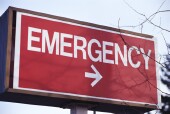- Skip Storing This Everyday Product in the Fridge Door
- Green Tea + B3 Pairing May Boost Brain Health
- Navigating Your Midlife Crisis: Embracing New Possibilities
- City Raccoons Showing Signs of Domestication
- Mapping the Exposome: Science Broadens Focus to Environmental Disease Triggers
- One Week Less on Social Media Linked to Better Mental Health
- Your Brain Changes in Stages as You Age, Study Finds
- Some Suicide Victims Show No Typical Warning Signs, Study Finds
- ByHeart Formula Faces Lawsuits After Babies Sickened With Botulism
- Switch to Vegan Diet Could Cut Your Greenhouse Gas Emissions in Half
More Kids Using ERs for Medical Care, Researchers Say


More children are going to the emergency room for health care, a new California study reveals.
Children’s visits to the emergency room in California hospitals increased 11 percent between 2005 and 2010. At the start of the study, 2.5 million children were seen in the ER. By 2010, 2.8 million children visited the ER each year, according to the study released Oct. 14 in the Journal of the American Medical Association.
Children on Medicaid made up 44 percent of the visits overall, according to the study. The proportion of Medicaid-insured patients increased over the five-year period, likely due to the economic recession, the authors wrote.
However, visits from children in all insurance categories increased over that time period, with a particular jump in 2009, the study found.
The two groups with the biggest climbs in emergency room use were uninsured and privately insured children. Visits from uninsured children increased 23 percent, according to the study. And, visits from privately insured children increased 15 percent, while visits from children on Medicaid increased 7 percent, the study reported.
“The most surprising finding was that the rate of growth of emergency department visits from privately insured children has outpaced that of children insured by Medicaid,” said lead researcher Dr. Renee Hsia, director of health policy studies in the department of emergency medicine at the University of California, San Francisco.
“People tend to think privately insured individuals have access to primary care and therefore go to the emergency department less often,” she said. “Our study shows that even privately insured children do go to the emergency department quite frequently and that their rate of utilization is increasing faster than even those on Medicaid.”
Because this study covers 2005 through 2010, it captures trends before the Affordable Care Act (ACA) would have had an impact. The ACA was signed into law in March of 2010, but most of the law’s major features didn’t go immediately into effect, according to the U.S. Department of Health and Human Services.
However, even now with the law nearly fully implemented, Hsia said she doesn’t believe there would be major differences today from what her study showed.
“The ACA increases insurance coverage but does not significantly address issues about access to care, whether it is primary care or emergency care,” she said. “It is important to remember that insurance coverage does not equate to access to health care.”
Even after previously uninsured individuals get health insurance, they must still find doctors and clinics for treatment. Medicaid-insured individuals may have a difficult time finding primary care doctors or specialists who will see them, Hsia said.
“Because of this, newly enrolled patients may still have the emergency department as their only real option for health care in certain situations,” she said.
Going to the emergency department instead of a primary care doctor for a non-emergency health issue has significant drawbacks, though, said Adam Powell, a health economist and president of Payer+Provider Syndicate.
“The order in which patients are treated is determined by both urgency and arrival time, so it can take a lot longer for a kid with a non-urgent condition to receive treatment in an emergency room than it would in a pediatrician or family physician’s office,” he said.
Treatment costs are also far higher in an emergency department than in a doctor’s office, Powell said.
“Just as it costs more to buy milk at a convenience store than at a supermarket, as the convenience store must be staffed during all hours of the day, it costs more to provide care at an emergency room, as emergency rooms must be constantly staffed and have ready access to numerous advanced resources within a hospital,” he said.
The study did not look at the reasons for the emergency room visits, but Hsia said that other research has shown that only a small percentage of those visits are actually for non-emergencies. In addition, the meaning of “emergency” can vary for different families, she said.
“If a parent believes their child has a condition that needs to be seen urgently and there is no other provider willing to see them, then certainly they should bring their child to the emergency department,” Hsia said.
Although the study focused only on California emergency departments, Hsia said Medicaid reimbursement patterns are similar across the United States, so she would expect to see similar results nationally.
“The fact that we find increases in the rates of growth of emergency department visits for privately insured children suggests that it is not only a reimbursement issue but also an issue of access overall,” she said. “It may signal the increasingly central role that the emergency department plays in health care in general.”
The study was funded by the California HealthCare Foundation and the U.S. National Institutes of Health.
More information
Learn more about when it’s a good idea to go to the emergency room from the American College of Emergency Physicians.
Source: HealthDay
Copyright © 2025 HealthDay. All rights reserved.










